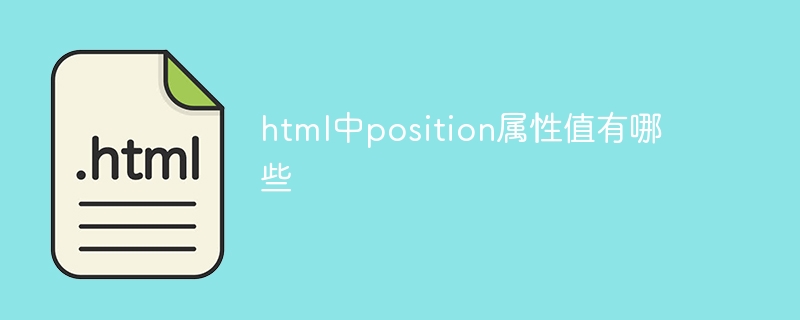What are the values of the position attribute in html?
The position attribute values in html include static, relative, absolute, fixed, sticky, etc. Detailed introduction: 1. static, elements are arranged according to the normal document flow and will not be affected by positioning; 2. relative, elements are positioned relative to their normal positions; 3. absolute, elements are positioned relative to their nearest positioned ancestor elements Positioning; 4. fixed, the element is positioned relative to the viewport; 5. sticky, etc.

# Operating system for this tutorial: Windows 10 system, Dell G3 computer.
In HTML, the position attribute is used to define how an element is positioned. It has the following attribute values:
static (default value): elements are arranged according to the normal document flow and will not be affected by positioning. The left, right, top, and bottom attributes are not valid for statically positioned elements.
relative: The element is positioned relative to its normal position. You can adjust the position of elements using the left, right, top, and bottom attributes. Relative positioning does not affect the position of other elements, and the space it occupies is still retained.
absolute: The element is positioned relative to its nearest positioned ancestor element. If there is no positioned ancestor element, positioning is relative to the root element of the document. You can adjust the position of elements using the left, right, top, and bottom attributes. Absolute positioning breaks away from the normal document flow and does not occupy the space of other elements.
fixed: The element is positioned relative to the viewport, and the element's position will not change even if the page scrolls. You can adjust the position of elements using the left, right, top, and bottom attributes. Fixed positioning breaks away from the normal document flow and does not take up space from other elements.
sticky: Elements become fixedly positioned when scrolled to a specific position, otherwise they are arranged according to normal document flow. You can adjust the position of elements using the left, right, top, and bottom attributes. Sticky positioning is positioned relative to its parent element or viewport.
These position attribute values can be specified through CSS style sheets or inline styles. By adjusting the position and positioning of elements, various layout effects and interactive effects can be achieved.
The above is the detailed content of What are the values of the position attribute in html?. For more information, please follow other related articles on the PHP Chinese website!

Hot AI Tools

Undresser.AI Undress
AI-powered app for creating realistic nude photos

AI Clothes Remover
Online AI tool for removing clothes from photos.

Undress AI Tool
Undress images for free

Clothoff.io
AI clothes remover

Video Face Swap
Swap faces in any video effortlessly with our completely free AI face swap tool!

Hot Article

Hot Tools

Notepad++7.3.1
Easy-to-use and free code editor

SublimeText3 Chinese version
Chinese version, very easy to use

Zend Studio 13.0.1
Powerful PHP integrated development environment

Dreamweaver CS6
Visual web development tools

SublimeText3 Mac version
God-level code editing software (SublimeText3)

Hot Topics
 1664
1664
 14
14
 1423
1423
 52
52
 1317
1317
 25
25
 1268
1268
 29
29
 1246
1246
 24
24
 Table Border in HTML
Sep 04, 2024 pm 04:49 PM
Table Border in HTML
Sep 04, 2024 pm 04:49 PM
Guide to Table Border in HTML. Here we discuss multiple ways for defining table-border with examples of the Table Border in HTML.
 Nested Table in HTML
Sep 04, 2024 pm 04:49 PM
Nested Table in HTML
Sep 04, 2024 pm 04:49 PM
This is a guide to Nested Table in HTML. Here we discuss how to create a table within the table along with the respective examples.
 HTML margin-left
Sep 04, 2024 pm 04:48 PM
HTML margin-left
Sep 04, 2024 pm 04:48 PM
Guide to HTML margin-left. Here we discuss a brief overview on HTML margin-left and its Examples along with its Code Implementation.
 HTML Table Layout
Sep 04, 2024 pm 04:54 PM
HTML Table Layout
Sep 04, 2024 pm 04:54 PM
Guide to HTML Table Layout. Here we discuss the Values of HTML Table Layout along with the examples and outputs n detail.
 HTML Input Placeholder
Sep 04, 2024 pm 04:54 PM
HTML Input Placeholder
Sep 04, 2024 pm 04:54 PM
Guide to HTML Input Placeholder. Here we discuss the Examples of HTML Input Placeholder along with the codes and outputs.
 How do you parse and process HTML/XML in PHP?
Feb 07, 2025 am 11:57 AM
How do you parse and process HTML/XML in PHP?
Feb 07, 2025 am 11:57 AM
This tutorial demonstrates how to efficiently process XML documents using PHP. XML (eXtensible Markup Language) is a versatile text-based markup language designed for both human readability and machine parsing. It's commonly used for data storage an
 HTML Ordered List
Sep 04, 2024 pm 04:43 PM
HTML Ordered List
Sep 04, 2024 pm 04:43 PM
Guide to the HTML Ordered List. Here we also discuss introduction of HTML Ordered list and types along with their example respectively
 HTML onclick Button
Sep 04, 2024 pm 04:49 PM
HTML onclick Button
Sep 04, 2024 pm 04:49 PM
Guide to HTML onclick Button. Here we discuss their introduction, working, examples and onclick Event in various events respectively.




